
A&S Landscape was very competitive. We chose them based on the time they had invested before we ordered.
Outdoor leisure and sporting activities are a key part of any local community, not only do they promote exercise and fitness, they offer an opportunity for people to come together. Whether as a spectator or a participant, the appeal can be somewhat hampered by the elements making it a challenge to get the most out of all-weather pitches and the like.
Our Covered MUGA™ is a clever and contemporary solution. Expertly designed to ensure minimal posts and wide-spanning coverage, this is a cost-effective, long-lasting, and highly durable structure that really does ensure all-year-round use! If you are a sporting facility that has evening sessions, then we can add floodlights to allow play even in the heart of winter.
Size and specifications are entirely bespoke meaning we have the flexibility to work with varying heights and spans. Whether you are a sporting facility looking to cover tennis courts or a school or a college who want to offer your students the best sporting chance and generate some extra revenue by hiring out the facilities for community use, we definitely have a solution for you. If you prefer to make a splash, then we can cover your swimming pool too.
In recent years we are proud to have worked with The Football Association to design, manufacture and install spectator stands at their training facility and to have created an archery training building for Team GB. Please do get in touch to find out more!

A&S Landscape was very competitive. We chose them based on the time they had invested before we ordered.

A&S Landscape was clearly the right company. They worked very well with everyone on the site.

A&S Landscape worked in a way that let us get other trades to fit around them. We’re happy to work with A&S again.
 The Brier School work to give their students the best experiences possible, and that includes sporting opportunities. They hold cricket games, relay races, and more. They even encourage pupils to get out on bikes and trikes in their break times. They wanted to encourage sports more, but the British weather often stopped pupils from getting outside. To counteract this, the school started looking into our range of sports canopies. They found the Covered MUGA that we provide and had it installed. Now they have a fantastic all-weather space for sports. Pupils can get outside and play whenever they want, without worrying about the rain. They can also take part in more sports, as there’s no chance of games being rained off. Pupils love having the chance to get outside on their breaks now, whatever the weather. Overall, it’s drastically improved the lives of the students. To read more about The Brier School’s covered games area, click here.
The Brier School work to give their students the best experiences possible, and that includes sporting opportunities. They hold cricket games, relay races, and more. They even encourage pupils to get out on bikes and trikes in their break times. They wanted to encourage sports more, but the British weather often stopped pupils from getting outside. To counteract this, the school started looking into our range of sports canopies. They found the Covered MUGA that we provide and had it installed. Now they have a fantastic all-weather space for sports. Pupils can get outside and play whenever they want, without worrying about the rain. They can also take part in more sports, as there’s no chance of games being rained off. Pupils love having the chance to get outside on their breaks now, whatever the weather. Overall, it’s drastically improved the lives of the students. To read more about The Brier School’s covered games area, click here.
 Football matches happen in all weathers, and that means that the fans come out in all types of weather too. It’s hard for them though, as much as they love their team, they don’t want to be sat out in the freezing rain all afternoon and Horsham Football Club was aware of this issue. They chose the Motiva Cantilever from our range of products to create a large shelter that spectators can stand under. Now, even if it’s raining, they can come out to cheer the team on and not get wet. It also creates a covered walkway for everyone who uses the building, so they can move around the building without going out into the rain. It’s proven to be a big hit at the club. See more about Horsham Football Club’s covered walkway here.
Football matches happen in all weathers, and that means that the fans come out in all types of weather too. It’s hard for them though, as much as they love their team, they don’t want to be sat out in the freezing rain all afternoon and Horsham Football Club was aware of this issue. They chose the Motiva Cantilever from our range of products to create a large shelter that spectators can stand under. Now, even if it’s raining, they can come out to cheer the team on and not get wet. It also creates a covered walkway for everyone who uses the building, so they can move around the building without going out into the rain. It’s proven to be a big hit at the club. See more about Horsham Football Club’s covered walkway here.
 Haileybury College is an esteemed residential school, that aims to give their students the best learning experience. That includes education and support, but also sporting opportunities. They had the grounds for sporting events, but the weather often got events called off if it turned bad. They started looking into sports canopies for the area, so their students could take full advantage of the space they had. They came to us looking for a solution and decided on a Covered MUGA canopy for the area. Now, they can play sports whenever they want. The canopy protects the ground from rain, so no more getting wet when trying to enjoy a game of football or basketball. With additional features added by the school, such as table tennis tables and anti-static sports turf, it’s become the perfect place to play sports and enjoy the outdoors. Click here to see more about the Covered MUGA at Haileybury College.
Haileybury College is an esteemed residential school, that aims to give their students the best learning experience. That includes education and support, but also sporting opportunities. They had the grounds for sporting events, but the weather often got events called off if it turned bad. They started looking into sports canopies for the area, so their students could take full advantage of the space they had. They came to us looking for a solution and decided on a Covered MUGA canopy for the area. Now, they can play sports whenever they want. The canopy protects the ground from rain, so no more getting wet when trying to enjoy a game of football or basketball. With additional features added by the school, such as table tennis tables and anti-static sports turf, it’s become the perfect place to play sports and enjoy the outdoors. Click here to see more about the Covered MUGA at Haileybury College.
 Zaytouna Primary School wanted to be able to create more sporting space for their pupils, but they didn’t have indoor space for it. They had outdoor grounds that worked perfectly, but of course they had to think about the weather. If it rained, how were the pupils going to play sports? They got in touch with us to see what could be done. Looking at our sports canopies, they decided to use a Covered MUGA for their sports grounds. This was the best decision, as they now have a dedicated sports grounds that can be used all year round. They’ll no longer have to worry about games being rained off, and both players and spectators can stay dry. It’s created a lot more opportunity for the pupils of the school, as they can now get outside and play a game without worrying about the weather. To read more about the covered sports pitch at Zaytouna Primary School, click here.
Zaytouna Primary School wanted to be able to create more sporting space for their pupils, but they didn’t have indoor space for it. They had outdoor grounds that worked perfectly, but of course they had to think about the weather. If it rained, how were the pupils going to play sports? They got in touch with us to see what could be done. Looking at our sports canopies, they decided to use a Covered MUGA for their sports grounds. This was the best decision, as they now have a dedicated sports grounds that can be used all year round. They’ll no longer have to worry about games being rained off, and both players and spectators can stay dry. It’s created a lot more opportunity for the pupils of the school, as they can now get outside and play a game without worrying about the weather. To read more about the covered sports pitch at Zaytouna Primary School, click here.
 There are plenty of spectators that want to come along to games at Haughmond Football Club, but the weather doesn’t always allow it. In the rain, it’s a cold and miserable affair. In the summer, it’s far too hot to enjoy the game. The club wanted to add a shelter for their spectators so they’d be protected from the weather no matter what, so that’s what they did. The team talked to us to see what sports canopies we could offer. They chose to use a Motiva Linear to give the spectators the best viewing experience possible. The shelter now keeps the rain off, so they can stay dry no matter how hard the rain comes down. The roof is also able to block some UV rays, so it’s much more comfortable in the summer months, too. To read more about Haughmond Football Club’s spectator shelter, click here.
There are plenty of spectators that want to come along to games at Haughmond Football Club, but the weather doesn’t always allow it. In the rain, it’s a cold and miserable affair. In the summer, it’s far too hot to enjoy the game. The club wanted to add a shelter for their spectators so they’d be protected from the weather no matter what, so that’s what they did. The team talked to us to see what sports canopies we could offer. They chose to use a Motiva Linear to give the spectators the best viewing experience possible. The shelter now keeps the rain off, so they can stay dry no matter how hard the rain comes down. The roof is also able to block some UV rays, so it’s much more comfortable in the summer months, too. To read more about Haughmond Football Club’s spectator shelter, click here.
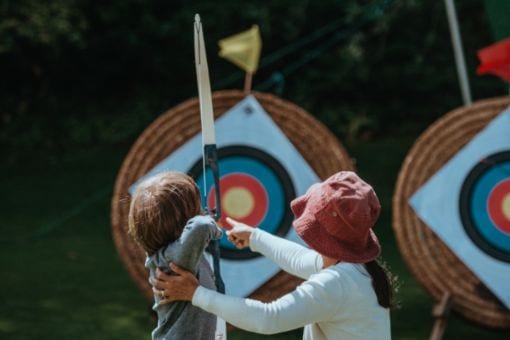 Archers describe their sport as being magical. They get a buzz from watching their arrow soar through the air. Even if the final destination of said arrow happens to be the dirt, they don’t mind. It’s all part of the sport. Perhaps it’s this attitude combined with the sport’s ancient roots in survival warfare that makes archery a popular game for both hobbyists and for the more serious sports type.
Archers describe their sport as being magical. They get a buzz from watching their arrow soar through the air. Even if the final destination of said arrow happens to be the dirt, they don’t mind. It’s all part of the sport. Perhaps it’s this attitude combined with the sport’s ancient roots in survival warfare that makes archery a popular game for both hobbyists and for the more serious sports type.
Stemming from Babylonian times, from way back in 2340BC, archery has a long history as one of the oldest sports in the world. It wasn’t a sport back in 2340BC though, it was a source of protection and survival. A mode of combat.
To play archery, you’ll need some equipment: a bow, some arrows and a target. All of which can be handmade (making your own equipment is something you might enjoy doing if you’re a hobbyist). You can also purchase pre-made archery equipment to suit your level, from beginner all the way through to Olympic champion. The aim of the game is to shoot your arrows at a target with as much accuracy and skill as you can muster. Which, of course, develops over time and with practise.
As you can imagine, archery is a dangerous sport. Bows and arrows were once weapons. Due care and attention are necessary at all times to play this sport safely. You should always play in an indoor or outdoor location where there is no risk at all of your archery practise causing harm to other people, or animals. Schools that offer archery as a sport will need to seek the appropriate advice to ensure their risk assessments are foolproof. Failure to do so could land you in hot water faster than you can shoot your arrow. Which led us to question: Is archery legal in the UK?
The answer is, yes. Up to now, the bow and arrow are not listed as a prohibited weapon. Nor as an offensive weapon, and there’s no need to licence your equipment either. You can keep up to date on any changes in legislation concerning archery here.
Running, jumping, throwing and walking all fit into the broad sports category of athletics. World Athletics, the international governing body for the sport, acknowledges six disciplines of athletics:
 You’ll also find sports like pole jumping, hurdles, javelin and shot put sitting under the umbrella of athletics too. It’s an interesting and broad sport with multiple disciplines to take part in.
You’ll also find sports like pole jumping, hurdles, javelin and shot put sitting under the umbrella of athletics too. It’s an interesting and broad sport with multiple disciplines to take part in.
All forms of athletics tend to encourage skills in stamina, speed, coordination, strength and endurance. And all athletic sports can be a true test of the human body. Often pushing it to limits (amongst pro-athletes) that no man has ever gone before. Amateur athletes, and pros alike, will usually work on improving their personal best scores. And to accomplish this goal they may need to develop core strength, confidence, and focus. Or, they’ll participate in other sports, like swimming, for example, to enhance their stamina.
The ability to compete with themselves is a satisfying experience for most athletes. Giving them a dopamine hit every time they see an improvement in their performance. We can see the appeal. But the benefits of participating in athletic games reach far beyond a dopamine hit. Most sports, including athletics, require skill sets like repetition, learning, memorisation, problem-solving, collaboration, determination and goal-setting skills. All of which can directly and positively influence the work you might do in the classroom, or in your job. They’ll also improve confidence, esteem and social interactions while providing an outlet for stress. Oftentimes, an athlete is too focused on their game to be interested in unhealthy decisions like smoking or drinking. Which further compounds the advantages of participating in sports like athletics.
Most people are familiar with athletics, whether you loved or hated the 100-metre track at school, chances are you’ve run one at some point in your life. If you decide to take up athletics or plan to encourage more participation in your schools, you’ll be making a good choice. Especially because, in most situations, you can garner the benefits mentioned above with very little financial input.
 Not to be mistaken with rugby, soccer or British football, American football, is a different game entirely. So why do we confuse these games? Mostly because American football has roots in both football and rugby. It’s the metaphorical cousin — blending rules from both British football and rugby into a different and equally loved sport. And if you are wondering where soccer comes in, it is the name American’s give to the same game that we call football.
Not to be mistaken with rugby, soccer or British football, American football, is a different game entirely. So why do we confuse these games? Mostly because American football has roots in both football and rugby. It’s the metaphorical cousin — blending rules from both British football and rugby into a different and equally loved sport. And if you are wondering where soccer comes in, it is the name American’s give to the same game that we call football.
The equipment worn by American football players sets it apart from all the above-mentioned sports. They wear helmets, mouth guards, shoulder pads, thigh and knee pads, compression shorts or a jockstrap, and the occasional protective cup. This is a full contact sport and not one for the faint-hearted. So why is there a need for all of this armour? The answer lies in the nature of the game.
Players tackle the player holding the ball. You can only tackle the player who holds the ball in American football. This means that one player may take a lot of force from several players at once during an 80-minute game. In contrast, with rugby, the players make lateral passes from one player to another. Making it difficult to tackle the player holding the ball, if you don’t know where the ball is. Plus, the game of rugby is shorter. This is one of the reasons why rugby players don’t need to wear the same level of protective clothing as American football players. And since a tackle in American football involves moves that need to take the player with the ball off their feet (to gain ownership of the ball), you can imagine that there can be a few knocks and scrapes along the way. Especially in an 80-minute game.
If you like rough and tumble sports, you might enjoy American Football. Don’t worry, it’s not a game reserved for Americans only. We play it in the UK on a domestic and international level, though it’s not too popular in UK schools … yet.
 Badminton, formerly known as ‘Poona’ is the fastest racquet sport worldwide. It’s not a surprising fact when you consider that shuttles can reach speeds of up to 200 miles per hour. Perhaps more surprising is the fact that badminton is the second most popular sport worldwide, second only to football. It’s a fast-paced, intense, and popular sport that is sure to get your blood pumping. And because of its popularity, you’ll easily find badminton courts to play on here in the UK, and around the world.
Badminton, formerly known as ‘Poona’ is the fastest racquet sport worldwide. It’s not a surprising fact when you consider that shuttles can reach speeds of up to 200 miles per hour. Perhaps more surprising is the fact that badminton is the second most popular sport worldwide, second only to football. It’s a fast-paced, intense, and popular sport that is sure to get your blood pumping. And because of its popularity, you’ll easily find badminton courts to play on here in the UK, and around the world.
Two to four players can play a game of badminton. In the case of four players, you’d play ‘doubles’. To play, you hit a shuttlecock across a net using badminton racquets and score points by landing your shuttlecock on your opponent’s side of the net. There are, of course, a few more rules to make the game both challenging and exciting but this is the basic overview of the game.
You may be wondering where the name ‘Poona’ came from and why it changed to badminton. Well, the game of badminton is the creation of villagers in an Indian town called Poona. Villagers there devised the rules and named the game after their village. This was way back in the mid 1800s. Officers from the British Army played with villagers in Poona back then and brought the game home. From there, the story differs depending on who you ask. Some say that the duke of Beaufort introduced the game at his estate in Badminton, Gloucestershire. Hence the new name. Other reports say officers introduced badminton to Folkestone in Kent by creating a badminton club. Both stories sound feasible, perhaps both scenarios occurred simultaneously?
If you’ve ever played rounders, you’ll have a basic understanding of how to play baseball. The two games are very similar, though baseball is played to more professional levels. In fact, baseball is at the heart of American culture, that’s why we often see portrayals of the game in many American movies. It’s the third most popular sport across the pond, sitting neatly behind basketball and American football.
In the UK, while many of us may have fond memories of summertime fun, playing rounders with family and friends, baseball isn’t as popular. Though baseball is a growing minor sport with a multi-tier national league, governed in the UK by the Baseball Federation. According to the Baseball Federation, as of 2016, approximately 22,000 British participants played a baseball, softball blend of the game. The numbers for baseball participants alone are significantly lower. This is unfortunate because baseball is a good sport for players at all levels of fitness, as there is an opportunity to rest during and in between play making it perfect for beginners.
 The rules for baseball are slightly different to the rules of rounders. The bats are also different, baseball bats are longer, and you can use two hands to bat. Rounders bats are shorter and rounder, you only need one hand to hit the ball. In rounders, you must run, even if you missed the ball, it’s the opposite of baseball.
The rules for baseball are slightly different to the rules of rounders. The bats are also different, baseball bats are longer, and you can use two hands to bat. Rounders bats are shorter and rounder, you only need one hand to hit the ball. In rounders, you must run, even if you missed the ball, it’s the opposite of baseball.
So you might be asking what is baseball? It’s a bat and ball game. There are two teams (fielders and a batting team) and a series of bases. The aim of the game is for the batting team to hit the ball far enough that they can run around all the bases as fast as possible — before the fielding team returns to a base with the ball. If you’re running in between bases, and the ball makes it back to the base you’re running to before you get there, you’re out. The batting team stays in play until the field puts out three batters. There are limits to the number of strikes and balls a batter can experience before he’s out. The team that scores the most runs wins.
Basketball to the Americans is what football is to the Brits. It’s the number one American sport. Over here in the UK though, the story is entirely different. We’re hardly a hotbed for hoops. So getting the opportunity to play the game is difficult. Unless you’re fortunate enough to have the space to install your own hoops at your home.
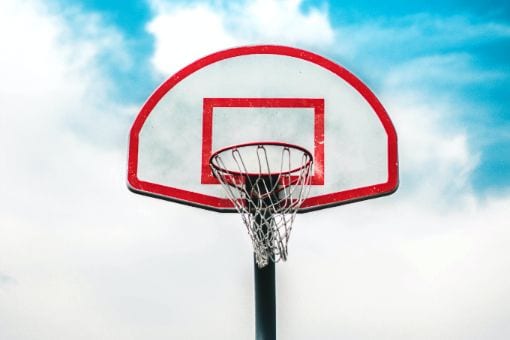 Unfortunately, there is little investment into the game of basketball in the UK, and the picture is as dismal when it comes to TV coverage too. However, there are reports from Sky Sports claiming that basketball is the second most popular sport in the UK, in terms of participation. Mostly amongst ‘black, Asian, and ethnic minority groups’. It seems as though basketball is an underground sport here in the UK that could rise in popularity in the coming years. Especially with the ‘Black Lives Matter Movement’, and with emphasis from the government to encourage more people to get outdoors, and become more involved with sporting activities. Perhaps one day we might see basketball hoops in our fields and parks, in the same way we see football goals.
Unfortunately, there is little investment into the game of basketball in the UK, and the picture is as dismal when it comes to TV coverage too. However, there are reports from Sky Sports claiming that basketball is the second most popular sport in the UK, in terms of participation. Mostly amongst ‘black, Asian, and ethnic minority groups’. It seems as though basketball is an underground sport here in the UK that could rise in popularity in the coming years. Especially with the ‘Black Lives Matter Movement’, and with emphasis from the government to encourage more people to get outdoors, and become more involved with sporting activities. Perhaps one day we might see basketball hoops in our fields and parks, in the same way we see football goals.
If you don’t know what basketball is, it’s a team sport, involving ten foot high hoops (baskets) and a rectangular court. Each hoop has a back board attached to make the ball bounce back onto the court—otherwise, you’d keep losing the ball! The object of the game is to toss the ball through the hoop on the opposing team’s side of the court, doing so scores points. The team with the most points wins. Players can dribble the ball around the court by bouncing it and running alongside the ball as they bounce it. The opposing team can tackle the player to take ownership of the ball as they move around the pitch. It takes a lot of skill with the ball, and stamina, to keep the ball in play and win the game.
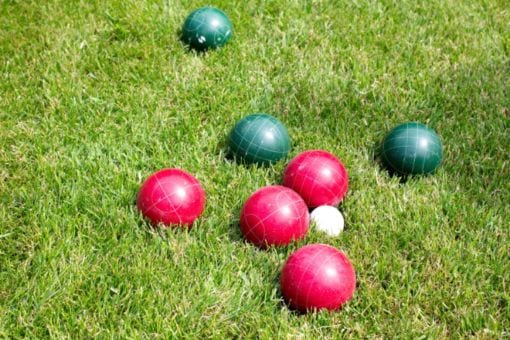 Moving on temporarily from the fast-paced sports, we take a peaceful stroll into a quieter, more typically British game. It might not be as glorious as some sports we’ve already mentioned, but bowls is a much-loved game. It’s especially appreciated by its dedicated players and is a perfect sport for social interaction and gentle exercise. The caveat being that bowls, while much loved in the UK, is not an originally British sport. It’s popular worldwide and has been that way for centuries — stemming all the way back to the ancient Egyptians.
Moving on temporarily from the fast-paced sports, we take a peaceful stroll into a quieter, more typically British game. It might not be as glorious as some sports we’ve already mentioned, but bowls is a much-loved game. It’s especially appreciated by its dedicated players and is a perfect sport for social interaction and gentle exercise. The caveat being that bowls, while much loved in the UK, is not an originally British sport. It’s popular worldwide and has been that way for centuries — stemming all the way back to the ancient Egyptians.
To explain how to play bowls, we must first discuss the equipment. You’ll need:
Bowls is often played at a bowls club, where there is usually a place to sit around, socialise, eat and drink and shelter from the elements along with one or more well-maintained bowling lawns (a bowling green). Reserved only for bowls. The lawn (or green) needs to be smooth to ensure accurate and fair gameplay. Needless to say, the bowling green is precious.
The objective of lawn bowling is to roll your bowl, so it lands as close to the target (the jack) as possible. The jack is rolled onto the green first, and then players take it in turns to roll their bowl onto the green. The player whose ball is closest to the jack scores the highest. When it comes to scoring, a tape measure is occasionally necessary to determine whose bowl is closest to the target.
The bowls themselves are not perfectly round, they have a bias. When you roll them, their path will curve. This forces the player to develop a technique for rolling his or her bowls to counter the bias. And it’s this element that adds to the game and creates complexity, interest, and competition. You need skill and patience to play bowls well.
 Are you looking for an interesting way to get in some upper-body cardiovascular exercise? Look no further than the sport of canoeing. There’s a reason why most gyms have rowing machines as standard. However, if you can access a canoeing club, or create one at your school, you’ll enjoy real canoeing even more than a workout in the gym.
Are you looking for an interesting way to get in some upper-body cardiovascular exercise? Look no further than the sport of canoeing. There’s a reason why most gyms have rowing machines as standard. However, if you can access a canoeing club, or create one at your school, you’ll enjoy real canoeing even more than a workout in the gym.
This sport takes you out into nature, onto rivers, lakes, and streams, and challenges your mental and physical metal just enough to give you a satisfying workout. It also provides a sense of competition and can restore your equilibrium.
A canoe is a lightweight water vessel, traditionally made out of wood and bark, or wood and canvas. Nowadays, they usually feature moulded plastic or fibreglass. A canoe usually has an open-top, a rounded base, and two points at either end of the vessel. Up to two canoers kneel inside the canoe and propel the vessel across the water, using a paddle. It’s crucial for the canoers to keep their body mass low to prevent their vessel from capsizing.
Canoeing is a fun pastime, hobby or competitive sport. It’s so competitive that it’s an Olympic sport. To make canoeing competitive, you’d typically race against other canoers. There are other types of canoe sports that feature in the Olympics like playboating, or white water canoes.
If you’re an adrenaline junkie, and canoeing seems a little too mild for you, don’t be put off. Playboating or white water canoeing will give you all the adrenaline kicks you need. Playboating is a sport where athletes on canoes (or kayaks) perform tricks similar to those you see in skateboarding or surfing. The tricks are performed in white water, on one fixed spot. And in most moves, the players are airborne during the trick. White water canoeing is where you take your canoe away from the serene still waters of a lake or river onto fierce, fast-moving rapids. The skills required for controlling the canoe in white water differ from those necessary for racing on a lake.
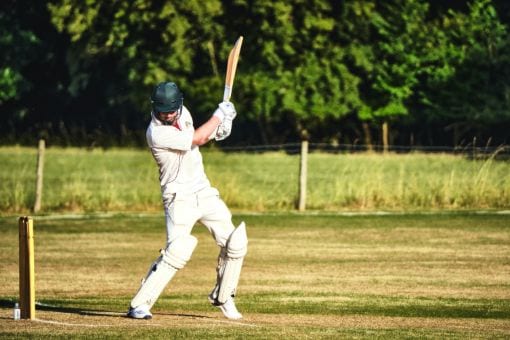 Finally, we land on a sport that originates from the UK, sixteenth-century south-east England to be precise. Cricket is the second most popular sport in the UK, with football being the first. Though that’s a bone of contention. Cricketers say their sport is the most popular and vice versa. You can see this rivalry between the two sports almost everywhere. If you read an article from somebody who favours cricket, they’ll tell you that cricket involves mental acuity, patience and skill and that football is pure adrenaline. On the other hand, a football-focused piece of information will complain about how long the game of cricket is and how much equipment is required in comparison to football. What both have in common is the undeniable passion of their fans, isn’t that what sport’s all about?
Finally, we land on a sport that originates from the UK, sixteenth-century south-east England to be precise. Cricket is the second most popular sport in the UK, with football being the first. Though that’s a bone of contention. Cricketers say their sport is the most popular and vice versa. You can see this rivalry between the two sports almost everywhere. If you read an article from somebody who favours cricket, they’ll tell you that cricket involves mental acuity, patience and skill and that football is pure adrenaline. On the other hand, a football-focused piece of information will complain about how long the game of cricket is and how much equipment is required in comparison to football. What both have in common is the undeniable passion of their fans, isn’t that what sport’s all about?
To play cricket, you’ll need a bat and a ball, along with a helmet, batting pads and gloves. You’ll also need a team (unless you’re practising), then you’ll need at least two people. A cricket team requires eleven people, however, you may play a match with fewer players by pre-agreement. One of the players in each team is the captain. The main object of cricket is to score as many runs as possible and more runs than the opposing team.
Scoring a run involves hitting a ball and then running from one pitch to another but this is a very simplified explanation. There are many nuances and complexities involved in cricket, which makes gameplay an exciting challenge for participants.
There’s an even bigger challenge with cricket though. You cannot play in the rain. Which isn’t ideal in UK weather. Batsmen find it difficult to see the ball in the rain, and the rain also slows down the speed of the ball. Which leads to many delayed or called off games. You can play cricket indoors, but the indoor game is modified to make it suitable for indoor play, it’s not quite the same but it’s perfect for schools to encourage sports all year round.
Not to be mistaken for the French apéritif, croquet is a game that could easily be introduced in schools, especially as a playground activity. It is perfect for encouraging children to get active, socialise, relax and keep their minds mentally stimulated. And is a low impact game. Making it perfect for players at all levels of fitness and all ages — from childhood through to the elderly. The game requires gentle physical activities like walking, swinging the mallet and bending. It’s a perfect, all-inclusive game. And a great opportunity for schools to encourage children to enjoy spending more time outdoors.
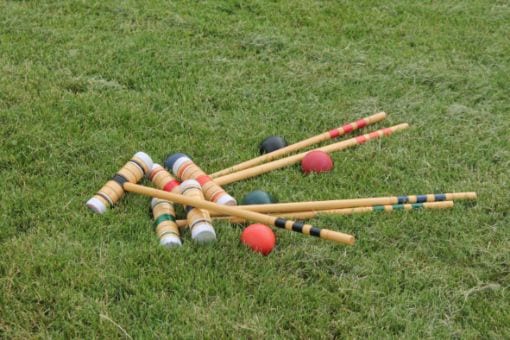 There are a few materials you’ll need to play croquet. You’ll need a croquet set. A basic set usually includes:
There are a few materials you’ll need to play croquet. You’ll need a croquet set. A basic set usually includes:
You’ll also need a flat green (lawn or field) to set up your hoops and centre peg upon, and a team of players. Though it is possible to practise alone.
The aim of the game is to hit your ball through the hoops in a sequence that ends when you finish the sequence and hit the ball against the centre peg. The sequence described usually features a series of right and left turns which are played in one direction then reversed — you end the course back where you started. You’ll usually play croquet as part of a team, and it’s the first team to complete the course who wins.
As we mentioned, croquet is a game of focus and precise hand-eye coordination. It stems from England and is now played by millions around the world today. It’s one of the oldest recreational sports. But don’t be misled by the rumours that this game is only played by small numbers of people. It’s wildly competitive and played by people from all walks of life.
This is a sport that doesn’t require any introduction. Dance is usually a fundamental part of any school’s after-school curriculum. And it’s easy to begin. All you need is some music, a hall — or space to dance in, and somebody to lead, or inspire, coordination.
This introduction merely paints a picture of dance in its most fundamental form. It doesn’t take into consideration all the history, the cultural influences, and different types of dance. Which is so vast that we couldn’t compile all the information into a few paragraphs. But to give you a guide, here are some of the most popular dance type categories (all of which incorporate several sub-categories of dance):
No matter what type of dance you choose to do, or introduce to your school, the dancers involved, who stay the course will inevitably develop advanced skills in personal discipline and focus. This is why it’s no surprise that many dancers tend to be hard workers and successful students.
Dancing also reduces stress. The cardiovascular exercise that comes from dancing prevents heart disease. And most committed dancers develop endurance, flexibility, agility, coordination, muscular strength and motor fitness. It’s an incredible outlet to counter most of today’s problems and you can take part indoors, or outdoors.
The sport of diving could refer to two very different activities: scuba diving or acrobatic diving.
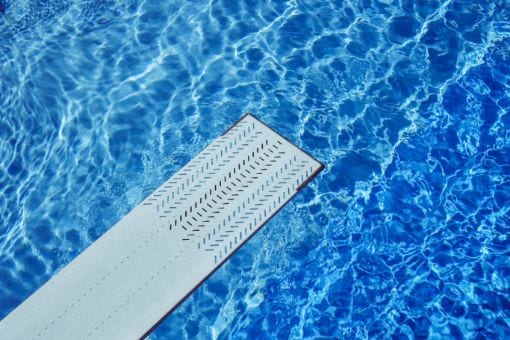 Scuba diving involves diving (or perhaps more accurately descending) below the water’s surface to explore the watery depths of lakes, rivers or the sea. To participate in scuba diving you’ll need equipment to help you breathe underwater. Scuba diving is a popular sport or pastime but it’s also a serious activity. There are several occupations involving scuba diving like search and rescue, or even underwater photography.
Scuba diving involves diving (or perhaps more accurately descending) below the water’s surface to explore the watery depths of lakes, rivers or the sea. To participate in scuba diving you’ll need equipment to help you breathe underwater. Scuba diving is a popular sport or pastime but it’s also a serious activity. There are several occupations involving scuba diving like search and rescue, or even underwater photography.
The sport of acrobatic diving is a major sport featuring in the Olympic Games, or the World Championships. In such games, divers will dive into deep water from a height of up to 27 metres for men and 20 metres for women. While diving, divers must adhere to a set of diving rules or requirements. During these games, divers must perform a specific number of dives. Some of which involve acrobatic moves like twists and somersaults.
The fundamental dive types are:
There are arm stands and twisting dives too. The best way to understand these dives are through the images featured here.
This is not a sport that is commonly taught in schools, perhaps because of the logistics and risks. Most UK schools don’t have their own swimming pool, or scuba diving facilities. But there are usually plenty of qualified out-of-school clubs and training facilities to teach you or your students.
If you’re looking for a fun playground sport, look no further than dodgeball. It’s a fast-paced game that involves running, dodging, ducking, dipping, throwing and catching and is perfect for burning off excess energy in the playground.
There’s a caveat though. This should be a supervised game to prevent boisterous activities from getting out of hand or any children from becoming a target of the ball. You’ll want to use a sponge ball in the playground, which is a suitable option for dodgeball.
So you might be asking, what is dodgeball?
Here’s your answer: Dodgeball involves two teams who throw balls at their opposing team in an attempt to hit their opponents with the ball — while dodging the ball themselves. If a player is hit by the ball, and they didn’t catch it, the throwing team wins a point. If the player catches the ball, the catching team receives the point. If the throw misses, there’s no point for any team.
The object of the game is to score as many points for your team as possible during the game. To add to the gameplay, each team starts out with one ball each. But there are another two balls available for the taking. These two balls are placed on the centre line at an even distance apart. The teams have to sprint to try to gain ownership of these two balls. Once the balls have been retrieved, the teams wait five seconds, to compose themselves before the first ball is thrown.
Foam balls are usually in play during dodgeball. With smaller balls featuring in dodgeball games with smaller children. The size of the sponge balls increases in line with the size of the children playing. There are no limits to the size or type of ball used. But you will commonly see foam, cloth or ‘no sting’ rubber balls as a preference. For obvious reasons — to reduce the risk of injury from the impact of the balls.
If you play dodgeball, you’ll develop skills in deflecting, blocking and throwing. Along with team playing, hand-eye coordination, focus and concentration.
Equestrian sports relate to horses and there are many types of equestrian sports you might wish to participate in. Some are more cultural and are location specific like western riding, rodeo, or stock handling. In the UK, the most popular equestrian sports are dressage, eventing, showjumping and racing. But there are equestrian games too like polo, made famous by the royal family.
As one of the oldest sports, equestrian sports featured in the ancient Olympic Games in 680BC. And features in the modern-day Olympic Games too, where you’ll see events like jumping, dressage and eventing.
In all equestrian sports, it’s necessary that the athlete builds trust with their horse. And both horse and human work in harmony with each other. The same applies to anybody who works with horses or enjoys a relationship with them as a pastime. Horses are sensitive creatures; they’ll train you as much as you train them. Which is part of the beauty and discipline of equestrian sports.
Like dancing, there are too many equestrian disciplines to detail them all in a few short paragraphs. So, we’ll explain the three main disciplines mentioned above. Those that you see in the Olympics.
Dressage involves testing the horse and athlete’s harmonious relationship and demonstrating athletic elegance. It’s sort of a talent show. It shows off the rider’s skill on the horse and with the horse. Moves include transitioning into a gallop, or the rider switching from side to side on the horse, and even prancing — that’s a move known as a ‘piaffe’.
Jumping involves racing horses over hurdles. It requires control, technical ability and courage.
Eventing is like a triathlon for horses and athletes involving jumping, dressage and cross-country riding. It takes skill, fitness and prowess to excel at this kind of sport.
Lunges, attacks, cuts and flicks might sound like warfare rather than sport. But these are the basic moves you’ll learn if you decide to take up the sport of fencing. It’s an Olympic sport that has been around for centuries and can be traced back to the late 1400s in Europe. Back then, though, it was a form of training for medieval combat. We were on the right track when we compared this sport to warfare! Yet, there’s a huge contradiction between what fencing was back in the 1400s and what it is today.
It’s an excellent sport for children to participate in. What most don’t realise is that fencing swords are flexible, safe and light. The ends of the swords are either blunt, capped with a ball, folded, or features a plunger — which lights up an indicator to alert that the sword touched the opponent. You can also play indoors or outdoors.
Fencing was first introduced into the Olympics in 1896. Since then, it has grown to be a popular sport in the UK, and a growing fringe sport in America. There are several types of fencing, including sabre, foil and épée.
In general, the first person to score 15 points wins the fencing match. But they must also have at least one point lead over their opponent to do so. If your opponent’s sword touches you while you’re holding your weapon — while you’re on guard (which means standing up straight) then you lose the round. There’s no need to keep fighting after that point.
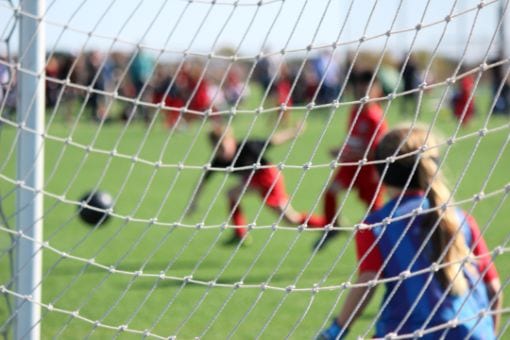 Football, or soccer as it is known in the US, has been around for a long time. It has grown to become one of the most popular sports in the world. And is played in more than 200 countries, uniting people from different cultures all globally. It has an estimated 265 million players and more than 5 million active registered teams. So it’s no surprise that most of us here in the UK know what football is — it’s played in most schools.
Football, or soccer as it is known in the US, has been around for a long time. It has grown to become one of the most popular sports in the world. And is played in more than 200 countries, uniting people from different cultures all globally. It has an estimated 265 million players and more than 5 million active registered teams. So it’s no surprise that most of us here in the UK know what football is — it’s played in most schools.
The origins of the game are uncertain, but reports claim that football has roots in medieval times. At first, it was a fun pastime, but as the decades rolled on, football became organised with professional and amateur teams.
The rules of the game have changed over the years, the most notable being when a British gentleman named James Naismith developed the rules for modern football as we know it today. These rules are straightforward but that doesn’t stop the game from becoming intense! The team that scores the most goals has won the match. After each goal, the play resumes from a predetermined point on the field and continues until the official blows a whistle to stop play.
The UK has a series of interconnected football leagues for men. Each year, clubs in each league compete against each other. At the end of the season, a certain number of the most successful clubs in each league can rise to a higher level. The bottom-ranked teams are sent down one or more levels based on their performance that season. In addition to sporting success, promotion is contingent on meeting criteria set by The Football Association. Appropriate facilities for players are required as well as finances from sponsorships. The Premier League is the top of all soccer leagues with elite and expert clubs. It’s followed by the national league then three regional leagues at the bottom for less-skilled players and clubs.
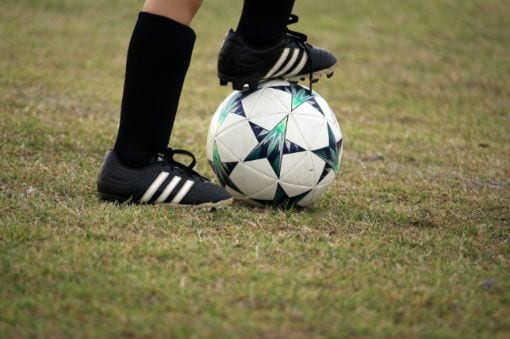 A lesser-known sport than Football, but a popular sport nonetheless is Goalball – it is played in over 40 countries worldwide, including Afghanistan, Denmark, Ireland, Israel and Japan and is recognised as an official Paralympic sport. Goalball is a team sport designed for athletes with visual impairments. Two teams compete to get a ball, containing bells, into the opponents’ goal area. There are three players on each team and as many substitutes as needed. Players use their feet or hands to move the ball around.
A lesser-known sport than Football, but a popular sport nonetheless is Goalball – it is played in over 40 countries worldwide, including Afghanistan, Denmark, Ireland, Israel and Japan and is recognised as an official Paralympic sport. Goalball is a team sport designed for athletes with visual impairments. Two teams compete to get a ball, containing bells, into the opponents’ goal area. There are three players on each team and as many substitutes as needed. Players use their feet or hands to move the ball around.
As we’ve already alluded to, this is a sport that was developed for people with visual disabilities. There are some instances where a goalball player is blind and has no light perception at all. There are other players who have low visual acuity to varying degrees, which means they can’t see things well. To make the game fair, everybody wears eyeshades during gameplay, so nobody will know what the other players’ sightlines look like.
Just because goalball is a game for the visually impaired, it doesn’t mean that schools can’t introduce the game to all children. It’s often played indoors on a gymnasium floor or basketball court but if your students are not visually impaired, there’s no reason why you couldn’t play outdoors.
The rules of the game are similar to that of football. But players use a ball with bells inside and have their own goal area. Players must stay within this goal area and can only move outside it if they’re retrieving the ball from behind the line. The player’s role on offence is to throw or roll (or “pass”) the ball in front of them towards one side of their opponent’s goal. While defending players try to stop them by intercepting or blocking the ball with any part of their body except their hands. This continues until one team scores two goals within two minutes – at which time they win.
If you want to introduce a new physical education activity into your school, then goalball might be for you. It’s an exciting game that is easy to learn and fun for all ages. While it’s played indoors professionally, if your players are not visually impaired, you could play outdoors.
You’ll typically play golf on a course (a large green field or area). A professional course has 18 holes while recreational courses often have nine. Golfers will use a teeing ground to begin their way around the course, and each green contains the hole or cup which is the target you are trying to sink your ball into.
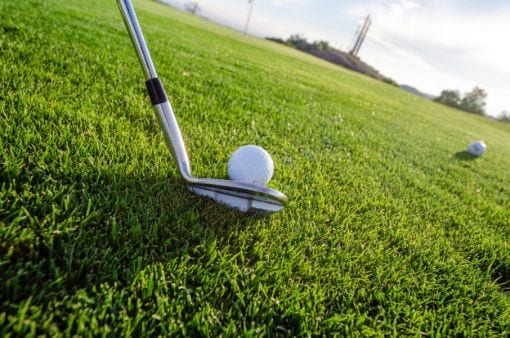 Golf is an intense and challenging sport and unlike most ball games, it doesn’t use a standardised playing area. So players need to be able to adjust their skills to cope with different terrains, which adds to the fun of the game. The terrain is a crucial element of golf courses, it enhances the game. You might play on fairways, roughs (long grass), bunkers or sand traps and see water hazards in between holes that are unique for specific golf layouts and arrangements. The terrain has an influence on the game, it can affect shots. For example, elevation changes make putting difficult. While slopes can assist you in getting closer to the hole with less effort.
Golf is an intense and challenging sport and unlike most ball games, it doesn’t use a standardised playing area. So players need to be able to adjust their skills to cope with different terrains, which adds to the fun of the game. The terrain is a crucial element of golf courses, it enhances the game. You might play on fairways, roughs (long grass), bunkers or sand traps and see water hazards in between holes that are unique for specific golf layouts and arrangements. The terrain has an influence on the game, it can affect shots. For example, elevation changes make putting difficult. While slopes can assist you in getting closer to the hole with less effort.
You can play golf in two different ways, scoring on either the lowest number of strokes by an individual to the lowest score on each hole. Stroke play most commonly occurs at all levels, but it’s seen more frequently in high-level tournaments. Usually because match play takes too long and doesn’t require as much strategy.
It’s believed that the ancient Egyptians created a form of golf as early as 3000BC, but many historians believe it may have originated even earlier than that. It’s been around for centuries. The modern game developed in Scotland in the 16th century and became popular with British aristocracy. It was originally played with clubs made out of sticks, and balls were made from leather stuffed into large animal intestines. Thankfully golf today is a much more refined game and is played both competitively and recreationally on golf courses all over the world.
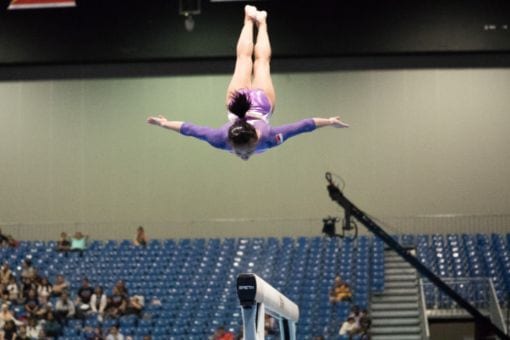 Moving onto a sport that requires tremendous physical strength, flexibility, and coordination – gymnastics. The word “gymnast” originates from the Greek word for ‘naked’ because gymnasts used to perform without clothes. In Ancient Greece, only men were allowed to compete in gymnastics events. They believed it would be unbecoming for women to participate because nudity was ‘shameful’. And because women’s bodies are weaker than men’s.
Moving onto a sport that requires tremendous physical strength, flexibility, and coordination – gymnastics. The word “gymnast” originates from the Greek word for ‘naked’ because gymnasts used to perform without clothes. In Ancient Greece, only men were allowed to compete in gymnastics events. They believed it would be unbecoming for women to participate because nudity was ‘shameful’. And because women’s bodies are weaker than men’s.
Today, female athletes are just as competitive in the sport of gymnastics as males. There is no longer any distinction between male and female competitors when it comes to what is acceptable in this sport and it’s no longer practised nude! Gymnastics has a long history founded in entertainment and demonstration of athleticism. Over the course of several centuries, it has evolved into one of many popular sports today.
The Federation of International Gymnastics (FIG) recognises eight unique disciplines of gymnastics. Each discipline has its own code of conduct, along with specific requirements for participation. Such requirements include strength, power and flexibility among other things. The disciplines identified by FIG include men’s artistic gymnastics, women’s artistic gymnastics, acrobatic gymnastics, rhythmic gymnastics and aerobic gymnastics.
To make it as a gymnast you’ll need to be focused and disciplined. Your skills will improve if you dedicate yourself to practise. And if not, well you can have fun exploring the sport, so long as you do so safely.
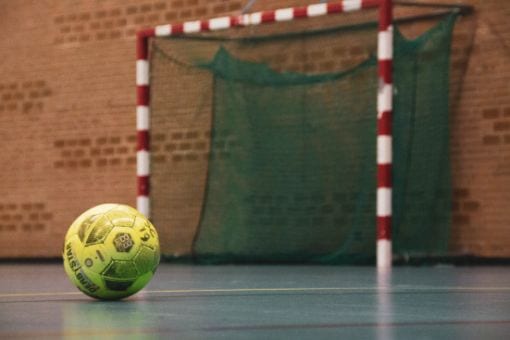 Have you heard of handball? It’s a game akin to basketball, but with easier gameplay and slightly different rules that causes many people to consider it to be a hybrid of basketball, football and netball. Handball may be somewhat unknown, but it is played all around the world and has been enjoyed for centuries. It’s played at schools, universities, and clubs as well as in public parks and gyms. It’s a perfect sport for schools.
Have you heard of handball? It’s a game akin to basketball, but with easier gameplay and slightly different rules that causes many people to consider it to be a hybrid of basketball, football and netball. Handball may be somewhat unknown, but it is played all around the world and has been enjoyed for centuries. It’s played at schools, universities, and clubs as well as in public parks and gyms. It’s a perfect sport for schools.
You can enjoy this game in teams of two or four players. And, as in many other sports, there are goals at each end of a rectangle court. All you need to play, as a minimum, is a handball and a flat surface of at least 30′ x 40′.
The object of handball is to score points by throwing the ball into your opponent’s goal while trying to defend your own goal from an opponent scoring a point. You have three minutes to make ten throws on one side of the court. Then you switch sides and repeat for another three minutes. This pattern continues until someone scores 21 points which completes a full game.
The ball used for handball is a hard, sticky rubber ball that can’t bounce off walls or the ground. The tacky residue is crucial for helping players grip and direct the ball. But it’s the kind that you can feel and experience when you touch the ball but that doesn’t leave a sticky residue on your hands when you play.
Handball promotes healthy habits, maintains cardiovascular fitness and burns calories. It also improves coordination, agility, reflexes and provides an aerobic workout with low impact on the joints. With all these bonuses you can’t beat this game, it’d be a great addition to your school sports curriculum.
People enjoy hockey because it’s fast-paced, intense, and unpredictable. There are several variations of hockey and multiple positions to play within these games. This diversity allows players to develop their skills in a variety of ways and have fun while doing so!
There are several variations of hockey, which include: Field Hockey, Ice Hockey, Roller Hockey and Street Hockey.
 Field hockey is a team sport, played on an artificial turf or grass pitch with curved sticks and balls. It requires two teams of 11 players who compete against each other by striking or defending the ball using the hockey sticks to direct the ball towards (or away from) the goals. It’s referred to as ‘field hockey’ to distinguish this game from ice hockey.
Field hockey is a team sport, played on an artificial turf or grass pitch with curved sticks and balls. It requires two teams of 11 players who compete against each other by striking or defending the ball using the hockey sticks to direct the ball towards (or away from) the goals. It’s referred to as ‘field hockey’ to distinguish this game from ice hockey.
Ice hockey is similar to field hockey but it’s played on ice or in an indoor ice rink. Players use similar curved hockey sticks to move the puck (the ice alternative to a hockey ball) around the ice. The rules for ice hockey are similar to field hockey but slightly adjusted to accommodate the ice. Ice hockey players claim they get exercise without feeling like they’re working out! They can skate around for hours without getting tired or bored!
Roller hockey is a game played on roller skates. It shares common elements with ice hockey and field hockey and is becoming an increasingly popular sport in the UK. To play roller hockey at your school you’ll need a sports hall large enough to accommodate a team of racing roller hockey players.
To encourage students to be active while learning valuable skills like discipline, respect, and self-defence, try introducing the sport of judo to your school. It’s also a fantastic way for children to learn a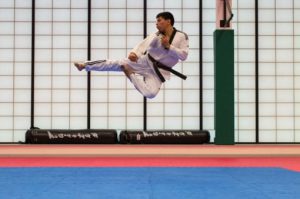 bout fitness and exercise while having fun. Schools that have started teaching judo report improved attendance rates, higher grades, better behaviour and more confidence among students.
bout fitness and exercise while having fun. Schools that have started teaching judo report improved attendance rates, higher grades, better behaviour and more confidence among students.
Originating from Japan, judo incorporates throwing or grappling techniques which are now practised all over the world and is now an Olympic event. The word judo comes from the Japanese words ‘ju’ meaning ‘gentle’ and ‘do’ meaning ‘way’. Judo means ‘the gentle way’, or ‘the way of yielding’. It was developed in the late 1800s by Jigoro Kano, who wanted to create an art for self-defence that could be practised without weapons.
As a martial art, Judo specialises in throws and immobilising opponents on the ground. Its most popular element of competition are takedowns, where an opponent must be thrown or taken down to the ground without using any striking weapons (such as hands). Judo also includes joint locks and chokes with no strikes allowed at all!
It’s easy to start teaching judo in your school – all you need is one qualified instructor, a sports hall and some soft mats.
You can learn judo at any age or fitness level, which makes it perfect for everyone from kids just starting out with sports to adults looking for a new way to stay fit. And because there are no strikes allowed in judo, you don’t have to worry about getting injured during training!
An alternative to judo and an ancient martial art originating from Japan is Karate. It stems from kung fu and has been around since the 17th century and remains a popular sport today. The sport involves using striking, kicking, blocking, throwing and grappling techniques to defeat an opponent. The style, moves, and sport of karate have changed over the years. And the sport we know today is more of a striking sport rather than a grappling, throwing sport, like judo. These grappling techniques are still taught today by some karate teachers.
 There are several forms of karate, all have varying degrees of emphasis on self-defence, sport competition, or physical exercise. Karate is a martial art that you can practise as an art, self-defence or combat sport. Traditional karate has an emphasis on self-development. While modern Japanese style training emphasises psychological elements such as perseverance, fearlessness, virtue, and leadership skills. Sport karate places emphasis on exercise with competition. Weapons feature in some styles of traditional Karate training.
There are several forms of karate, all have varying degrees of emphasis on self-defence, sport competition, or physical exercise. Karate is a martial art that you can practise as an art, self-defence or combat sport. Traditional karate has an emphasis on self-development. While modern Japanese style training emphasises psychological elements such as perseverance, fearlessness, virtue, and leadership skills. Sport karate places emphasis on exercise with competition. Weapons feature in some styles of traditional Karate training.
There are three main elements to practising this martial art; basics (kihon), forms (katas) and sparring (kumite). Karate training focuses on the three categories, starting with the basics to get you comfortable before moving on to more intense forms, like sparring where your skills are put into action.
As you progress in experience you’ll have the opportunity to take skill tests. If you pass these tests you’ll be awarded a coloured belt. Each belt colour symbolises your skill level in karate. There are six levels and subsequent belt colours. These start with the white belt and then progresses through to an orange belt. Blue, yellow, green and brown belts follow until you finally reach the black belt which symbolises mastery in karate.
Kayaking is an exciting water sport that you can do solo, or with friends. There are many kayaks to choose from – sit-on-top, recreational, inflatable and fishing kayaks. Each type of kayak is designed for the type of kayaking activity you’d like to do. Typical examples of kayaking activities include fishing, racing, exploring, learning and white water kayaking.
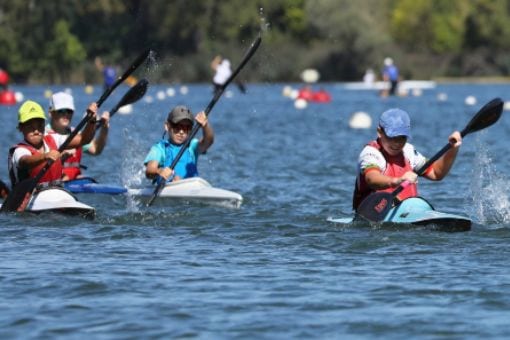 You can go kayaking in any body of water, but for safety reasons, it’s necessary to know your limits! Most people will kayak in rivers, lakes (flat water) or oceans. If you’re a beginner, you should make sure your first destination has calm waters and flat waves. Once you master the art of kayaking, you’ll want to explore new territory. That’s when you might try branching out with some more advanced forms of kayaking like white water rafting or even sea kayaking.
You can go kayaking in any body of water, but for safety reasons, it’s necessary to know your limits! Most people will kayak in rivers, lakes (flat water) or oceans. If you’re a beginner, you should make sure your first destination has calm waters and flat waves. Once you master the art of kayaking, you’ll want to explore new territory. That’s when you might try branching out with some more advanced forms of kayaking like white water rafting or even sea kayaking.
Most people confuse a kayak with a canoe and vice versa. Which is not surprising since they are alike. The main difference being the features of the vessel which influences the skills, experience and techniques you’ll use while kayaking versus canoeing.
The closed-deck design of a kayak provides protection from waves crashing over the top. It also creates more room inside, allowing you to sit down on your seat without feeling cramped or desperate for legroom. This design makes it easier to paddle yourself through choppy waters while maintaining control of where you’re going! This design is different to a canoe which tends to be open-top and higher. Rowers kneel, rather than sit.
Kayaks have a double-bladed paddle, where canoes feature single-bladed paddles. Double bladed paddles are faster, but they wear out the rowers faster.
These differences mean that kayakers will develop different skills and physical advantages to rowers using canoes. Their experience of different sports like racing or white water kayaking or canoeing will differ. The good news is that there are kayaking clubs all around the UK that provide services to both schools and the general public.
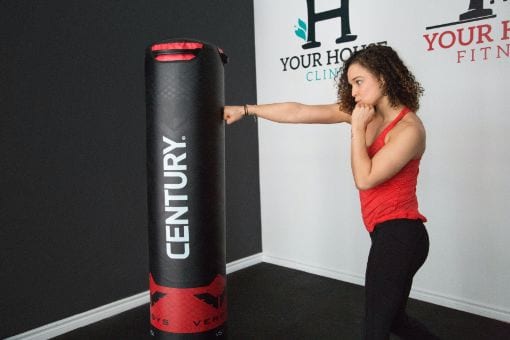 Martial arts are not just for adults, they’re also great for the kids. In fact, many schools in the UK have martial arts programs to help children stay healthy, confident and safe. One of the most popular forms of martial arts in school systems is kickboxing.
Martial arts are not just for adults, they’re also great for the kids. In fact, many schools in the UK have martial arts programs to help children stay healthy, confident and safe. One of the most popular forms of martial arts in school systems is kickboxing.
Kickboxing originated from Thailand and was developed by practitioners who wanted to learn self-defence without weapons. It was developed as an alternative to boxing and wrestling. Competitors could use their feet, knees, elbows and hands to perform well considered and incredibly disciplined moves in self-defence.
You play a game of kickboxing with two people who are opponents. The rules are simple. Punches should have contact with the head or torso area to count as a point. Kicks should have contact with the front leg below the knee to count as a point. No kicking above the waistline. No punching while holding onto your opponent’s clothing. So as you can see, these rules, combined with a professional instructor ensures safety while participating in this sport.
There are many benefits associated with kickboxing including weight loss, increased endurance, improved self-defence skills and confidence. It teaches students how to defend themselves with their hands and mind. While learning a new form of exercise that provides additional benefits such as fitness and discipline. This is accomplished through kicks, punches, blocks and more. Kickboxing also builds self-esteem, discipline and concentration skills in children and teaches them how to fight back safely, in self-defence, should they ever be attacked.
Could lacrosse be one of the most high-intensity sports we’ve mentioned? We think so. It’s a sport that requires players to have speed and strength. One of the most beneficial things about lacrosse is its effect on your body! Lacrosse forces you to burn many extra calories during intense training and is excellent for weight loss. Catching balls with the lacrosse stick and throwing them as hard as possible takes an immense amount of strength. So get ready for some serious muscle building when playing this exciting but tough game!
Originating in Native American communities, lacrosse was a training exercise for tribal warriors. In its early form, there were sometimes thousands of players on either side battling for victory. Today, it’s a team game in which players pass the ball back and forth, using their sticks (with mesh nets on the end) to put the ball into their goal on the opponent’s side. Teams in lacrosse include ten players: a goalkeeper, three attackers, three defenders and three midfielders.
 Lacrosse sticks differ in size, some are short, and others are long. The short sticks must measure between forty and forty-two inches. While the longer sticks must be between fifty-two and seventy-two inches long. The goalkeeper’s stick differs from both of the sticks mentioned above and can be between forty and seventy-two inches in length and up to fifteen inches wide. Excluding the goalkeeper’s stick, there can only be four long sticks in play at any time. The difference in stick sizes adds to the complexity of the game and increases gameplay.
Lacrosse sticks differ in size, some are short, and others are long. The short sticks must measure between forty and forty-two inches. While the longer sticks must be between fifty-two and seventy-two inches long. The goalkeeper’s stick differs from both of the sticks mentioned above and can be between forty and seventy-two inches in length and up to fifteen inches wide. Excluding the goalkeeper’s stick, there can only be four long sticks in play at any time. The difference in stick sizes adds to the complexity of the game and increases gameplay.
Helmets, mouthpieces, arm and shoulder pads and gloves are necessary ‘armour’ for this sport. This is because the ball is eight inches in diameter of solid rubber, and it’s thrown around the pitch with as much effort and force as the players can muster.
Invented in 1895, netball is the brainchild of women who wanted to play basketball but couldn’t because they had more clothing restrictions than men. Netball’s first name, “women’s basketball,” is a perfect example of how it grew as an adaptation from the original game. Which is now prevalent in most schools across the UK.
Two teams of seven players play netball on a rectangular court with raised goal rings at each end (similar to basketball hoops but smaller and lower). The winning team is the one that scores the most goals by moving the ball through the opposition’s defence and shooting the ball through the goal rings.
Players in this game can only hold onto their balls for three seconds before shooting it through the goal or passing to another player. Their movements are also restricted to certain areas of the court depending on what position the player holds. In netball, you can’t run with the ball, there’s no dribbling nor kicking. Instead, participants throw the ball from one player to another.
The combination of not being able to run with the ball and having to throw the ball within three seconds of gaining control means that netball players have to be quick thinking. They need to have a good idea of where their team players are on the court at any time, so they can quickly pass the ball. Netball involves teamwork, concentration, spatial awareness and rapid decision-making.
Games last 60 minutes, and the objective is to score more goals than your opposing team. Netball is mostly played outdoors, however, there are indoor versions too. With indoor netball, the court is often surrounded by a net that covers the whole court including overhead. The net stops the ball from bouncing off courts and allows for faster play. This is the kind of sport that is perfectly suited to an outdoor sports canopy which protects players from the elements and helps organisers avoid games and competitions being rained off, while still providing the experience of playing outdoors — due to the shelter’s open sides.
Orienteering’s aim is for participants to navigate between checkpoints (or marks on a special map) to complete a course. It involves critical thinking, decision-making and plenty of walking (or running if you prefer). Orienteers require suitable walking clothes and shoes, a compass and an orienteering map for the course or route you’re taking. The fun of the sport is to find the best way to go to complete your course in the best time possible. There’s no set route. The direction you take is up to you to work out. But there are checkpoints or marks on a map to help break up the course and keep you on track. Most people orienteer for fun, but it can also be competitive. In competitions, the objective is to complete the course the quickest out of all participants.
People go orienteering in all kinds of locations, there are courses in cities, in the suburbs and in nature. You’ll also find orienteering opportunities in parks, forests, playgrounds and everywhere else where it’s possible to walk. In most scenarios, participants will orienteer around a temporary or permanent course. And there are plenty of courses dotted around across the UK. You can find some of them by using this orienteering course finder or joining an orienteering club.
Schools can set up their own course, or take their students orienteering on some of the courses linked above, many of which are free. Each course is graded and categorised by a colour which highlights how technically or physically difficult each course is. White, orange and yellow courses are the easier options. Green, blue, brown and black courses increase in difficulty, with black being the hardest. This grading is very similar to the way routes are graded in other sports for example, in mountain biking or skiing, routes are graded by colour too. Black always seems to be the hardest.
Orienteering is a rewarding sport. If you’re able-bodied and can walk a short distance there will be a course to suit you. But you should always remember to start with the easiest courses first and work your way up as you build stamina and endurance.
Now we turn to a sport that requires a lot of strength, endurance, and technique — rowing. It’s considered both an aerobic and anaerobic exercise because it combines the use of leg power with upper-body arm movements to propel you forward. Rowers from high school to college, as well as adults compete internationally for rowing medals. While others enjoy it recreationally on lakes or rivers all over the world!
When a rower is sculling, they’re using their right hand to row while using their left hand to hold and steer. Oarsmen accomplish this by rotating their torso so that it becomes parallel with the boat’s line of motion. This technique is often used to move a boat from one side of an obstacle. Such as another boat or pier, to the other without having to turn around and go back to where they came from. It’s also useful for navigating tight spots.
Sweep rowing is a technique that rowers use to move their boat through the water and propel it forward. They hold the oar with one hand near the blade of the oar and extend it out in front of them, while holding onto a handle attached to the side of the boat with their other hand. A sweep rowing motion consists of thrusting the blade of the oar through the water and pulling it back towards themselves.
As a competitive sport, rowers compete in groups of two, four or eight people matched by how close their rowing ability is to one another. Competitors at the Olympic level often spend hours training each day on water and dry land. Usually six days per week. Competitions include racing, time trials, and head races.
Rowing is a great way to get in shape with the added bonus of building endurance without having to do anything too strenuous or difficult on your joints. It’s also not as expensive as many other sports because there are no special uniforms required. Unless you’re rowing for athletic clubs or competitive teams that require them.
If you were around back in 2003, you’ll remember the images of rugby player Jonny Wilkinson parading around in England’s rugby team bus, celebrating their World Cup win. But even before 2003, rugby was popular in the UK. Often introduced to students in schools and then continued by players into adulthood. But after that win, interest and participation in the sport of rugby increased. You won’t struggle to find a rugby club if you’re living in the UK.
 Rugby is a tough, but exciting sport that originates from England. It has since grown to be an international phenomenon with people from around the world playing it. It’s a contact sport. But, unlike many other contact sports, rugby doesn’t require protective equipment. As a full-contact sport, you’ll see players from both teams coming together to tackle a ball carrier or push them back during scrums.
Rugby is a tough, but exciting sport that originates from England. It has since grown to be an international phenomenon with people from around the world playing it. It’s a contact sport. But, unlike many other contact sports, rugby doesn’t require protective equipment. As a full-contact sport, you’ll see players from both teams coming together to tackle a ball carrier or push them back during scrums.
And for those that don’t know, a scrum occurs when the game is reset. Players pack together and push against one another to create momentum for hooking the ball back into their half of the pitch (taking control of the ball). They do this so they can advance onto the opposition’s line.
You play rugby with two opposing teams of fifteen players. The idea is to score more points than your opponent by passing, carrying or kicking the ball over their try line (the goal). You can only throw the ball backwards or laterally, and a goal in rugby is called ‘a try’.
Players in rugby are divided into two categories.
It’s a rough and tumble game that garners a lot of passion and camaraderie between teammates. And is one that is often played in schools across the UK.
You may know rounders as an informal outdoor pastime, or playground sport. But it’s also a serious bat and ball game. One that has evolved to become a professional sport, especially in places like Ireland.
Rounders is well known for having a more relaxed set of rules than other ball games such as cricket or baseball. The rules tend to vary from place to place but Rounders England and The Gaelic Athletic Association have created written rules for England and Ireland to make the rules coherent. A step that creates a better opportunity to learn and play the game competitively — in a professional arena.
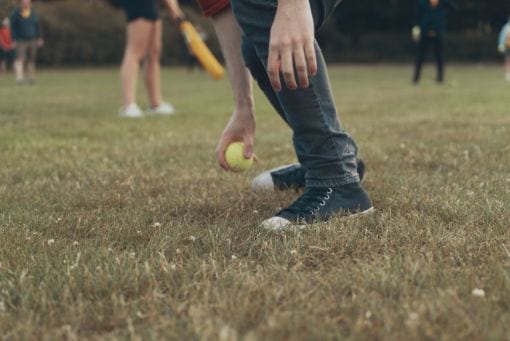 The game is played in two teams of four players and the team who reaches 21 points first, wins. The object of rounders is to hit a ball (which can be thrown or bowled) with a bat into an area as far from your competing players as possible. After batting the ball, players run around bases, in an attempt to return home before the ball makes it back to a base. There are five different bases that you can reach by running when the ball is batted: first base, close to where the batter starts; second base, third base and fourth base. Players run as fast as they can past each base and attempt to do so before the ball is returned to a base. If the ball reaches the base a player is running to first, the player is out. Players score higher points if they manage to run past all five bases in one go. The teams continue batting until a whole team is booked out, in which case the game is over.
The game is played in two teams of four players and the team who reaches 21 points first, wins. The object of rounders is to hit a ball (which can be thrown or bowled) with a bat into an area as far from your competing players as possible. After batting the ball, players run around bases, in an attempt to return home before the ball makes it back to a base. There are five different bases that you can reach by running when the ball is batted: first base, close to where the batter starts; second base, third base and fourth base. Players run as fast as they can past each base and attempt to do so before the ball is returned to a base. If the ball reaches the base a player is running to first, the player is out. Players score higher points if they manage to run past all five bases in one go. The teams continue batting until a whole team is booked out, in which case the game is over.
Many people confuse rounders with baseball, which is not hard to do, they have a lot of similarities. Both games use bats, balls and bases. But rounders is much simpler than baseball, with fewer rules to follow too.
It’s not just an English sport – countries like Sri Lanka and Canada play rounders which shows that this fun sport can be enjoyed anywhere. Furthermore, rounders is a wonderful outdoor playground sport that is easy for schools to implement. And for players to learn how to play with little supervision.
Padel is a racquet sport that originates from Spain and is most popular there. It’s played on a court similar to the one used for tennis, but with walls. The game combines elements of badminton, tennis and squash. In padel, you bounce balls off the wall and over a net hence the similarities between the sports mentioned above.
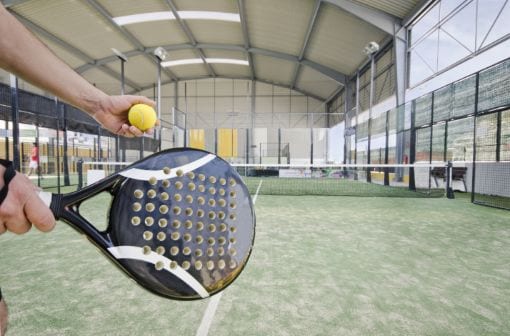 You’ll experience fast-paced volleys, smashes, drop shots, overheads and slices. All performed while running around the court at high speed! Padel offers more opportunities for players to move around than traditional racket sports like squash or badminton. Which makes it a perfect sport for those who want to keep their mind, as well as their body, active.
You’ll experience fast-paced volleys, smashes, drop shots, overheads and slices. All performed while running around the court at high speed! Padel offers more opportunities for players to move around than traditional racket sports like squash or badminton. Which makes it a perfect sport for those who want to keep their mind, as well as their body, active.
The object of padel is to hit the ball against the front wall so that it bounces on the opposite side of the net (the opponent’s side). The ball should then hit the ground within that half of the court before bouncing again. Accomplish this, and you score points. To defend, the opposition needs to prevent you from making clean shots such as those mentioned above. Scoring is the same as in tennis. You’ll play sets and the one who wins the best out of three sets wins the game.
It’s easy enough to learn padel but there are some elementary mistakes that beginners frequently make, which include:
Finally, beginners often do not think about how they will attack or defend themselves based on the position of their opponent on the court. If you’re a beginner, and you want to advance in padel, noting these mistakes, and working on countering them will help you improve your game fast.
In schools, padel is more suited to older children, why? Because it’s so fast-paced this often makes it difficult for younger children to grasp. But it’s an interesting sport for senior schools, colleges and universities.
You’ll play softball with two teams of nine players. The object of the game is to score more runs than your opponent by hitting a (soft) ball into play and running around four bases — in a sequence until you reach the home plate. And doing so without being tagged by the ball. There are five specific positions in the game. You’ll need a catcher, a pitcher, a first baseman, a second baseman, and a shortstop. It’s a game similar to baseball or rounders, but with a softer ball. And in the UK, there are more players of a baseball/softball version of the game rather than straight softball or baseball.
Softball starts with a man named George Hancock who was an avid baseball player in the 1940s. The first softball game came about during a football game between Yale and Harvard. When Yale won, Hancock excitedly threw a boxing glove at a Harvard supporter. From there the supporter playfully threw the glove on. Which led to George Hancock shouting, “Let’s play ball,” he then tied the boxing glove into the shape of a ball. Meanwhile, George’s friends chalked a diamond shape onto the floor, broke a broom handle to serve as a bat and began to play. That was the first game of softball. This was on Thanksgiving Day in November 1887. Hancock’s ‘indoor baseball’ quickly took off and softball was born.
The rules of the game are similar to that of baseball or rounders. And to play softball you’ll need the following equipment:
The great thing about softball lies in the nature of the game. The soft ball making it easier to play indoors, outdoors, or under a sports shelter to combine both elements.
Squash is a racquet sport that requires at least two players to play properly. You can play the game in matches incorporating singles or doubles.
The court consists of four walls made of wire mesh that are about twelve feet high. There is a small rectangular playing area in the centre called the “box,” which has a short, low net stretched across its width at about waist height. Players use one hand to hit a squash ball off either side wall back into play. When they fail to do this, they must allow their opponent to hit the ball back. To win a game of squash, a player or team must be ahead by two points at the end of play.
There are a few different types of squash that can be played which are:
The equipment you’ll need to play squash are:
The benefits of playing squash are that you are constantly on the move, and it’s a great way to get a full body physical and cardiovascular workout.
All people can enjoy swimming, regardless of their age or physical condition. It’s a sport that doesn’t require any special equipment (aside from a body of water — usually a swimming pool). It’s also a sport you can participate in all year-round, in any climate.
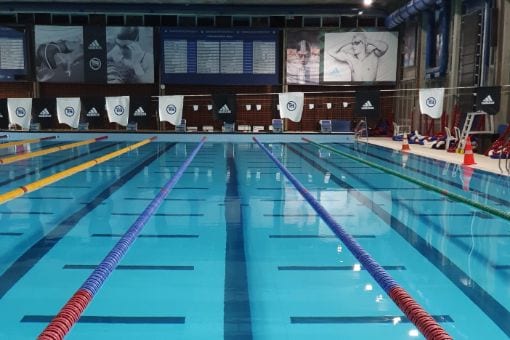 It’s a terrific form of exercise that provides many benefits to athletes and individuals alike. Including improved cardiovascular health, stress relief, increased muscle strength and endurance. Swimmers reap mental benefits that come from burning off excess energy or stress. As well as enjoying the de-stressing aspect of getting out into nature and spending time in the water. Competitive swimmers will also enjoy developing social connections through team sports. There’s a lot you can gain from swimming and nothing to lose!
It’s a terrific form of exercise that provides many benefits to athletes and individuals alike. Including improved cardiovascular health, stress relief, increased muscle strength and endurance. Swimmers reap mental benefits that come from burning off excess energy or stress. As well as enjoying the de-stressing aspect of getting out into nature and spending time in the water. Competitive swimmers will also enjoy developing social connections through team sports. There’s a lot you can gain from swimming and nothing to lose!
The Olympics is one event where swimming plays a major part. There are other, more attainable, swimming events too. Such as school swim meets that bring swimmers together from across the country for friendly competition.
There are a wide variety of events in competitive swimming, including individual events and relay. The toughest event is the medley relay. Four swimmers race to swim as fast as possible by performing a variety of strokes: Backstroke followed by breaststroke. Then butterfly, before finishing with freestyle strokes.
Competitive swimming also includes the individual medley — it’s like the medley relay but there’s no team to relay with, you’re in it alone. It’s a great accomplishment if you can complete the individual medley — even more so if you win it. There are other types of competitive racing in swimming too. These races focus on one swimming style. You’ll discover races for: butterfly stroke, backstroke, freestyle and breaststroke.
In schools, similar competitions to those featuring in the Olympics may be set up. Though they may require a lower distance or slower speeds. The English Schools Swimming Association helps to organise competitions and leagues for schools, some of their events include sports like synchronised swimming, water polo, and diving.
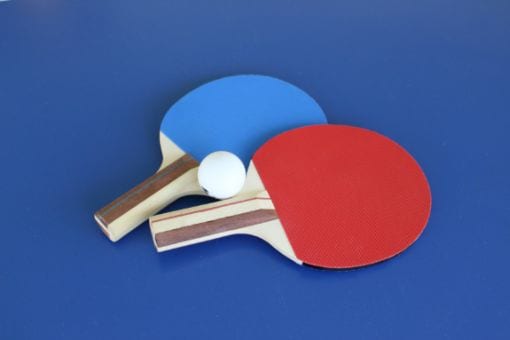 Here’s a fun and addictive game (and sport) that can be played by anyone of any age. Table tennis is easy to learn, but takes time and practise to perfect. You might know this game by its other name ‘ping pong’.
Here’s a fun and addictive game (and sport) that can be played by anyone of any age. Table tennis is easy to learn, but takes time and practise to perfect. You might know this game by its other name ‘ping pong’.
Players hit the ball back and forth (to and from their opponent) on a table tennis table that has a small net in the middle. The net divides one opponent’s side from the other and players use a paddle to hit the ball. The aim of the game is to hit the ball back over the net, without letting the ball go out of play, when it lands on your side. Ideally, you’ll hit the ball back in a way that makes it difficult for your opposing player to return the ball. The player who keeps the ball in play longer than their opponent scores a point. The first player to score 11 points wins.
There are some basic rules and etiquette that should be followed when playing table tennis. For example, you should keep your ball from the net as much as possible, so it doesn’t get caught on the net. This is called “netting” and it’s a foul if you do this. You’ll also want to avoid the back of your opponent’s table. This will interfere with their play space, they may not be able to hit the ball if you’ve blocked them off. Which again, will lead to a foul.
Aside from the etiquette, and to make the game interesting, players develop their skills in how they serve or spin the ball. Serving and spinning the ball is an art form. It’s crucial to learn how to do this well to keep your opponent on their toes. There are many various types of services, some more complicated than others. A couple of the more common serves are a “push” or an overhead serve.
When it comes to spins, which is a technique for influencing the movement of the ball, players use a variety of them. The two most basic spins in table tennis are a topspin and backspin.
You play tennis with two players (singles), or four players (doubles). The object of the game is to hit a tennis ball over a net (with a tennis racquet) in a way that prevents your opponent from returning the ball back over the net — while staying within the court markings. You score points by “winning” each rally, which means you have to hit more shots successfully than your opponent does. At the end of each game, whoever has the most points wins. Commonly grounds will feature tennis court covering systems or tennis court shade structures, which allow the games to continue during periods of wet weather.
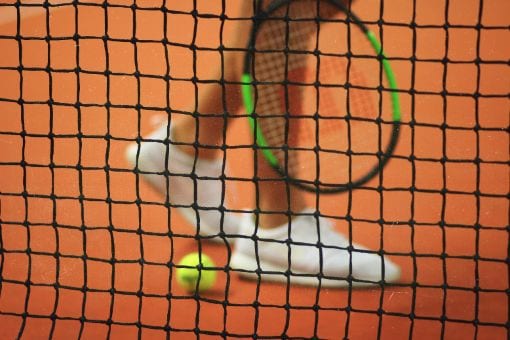 The world-famous Wimbledon Championships is the oldest and most prestigious tennis tournament in the world. Where 24 tonnes of strawberries are said to be consumed every year by the crowds. Speaking of prestigious, one of the highest accolades a professional tennis player can achieve is a Grand Slam — it’s the Holy Grail for tennis players. The Grand Slam is where a player wins all four major tournaments in a single year. These tournaments are Wimbledon, France, Australia, and the United States. Five players have won The Grand Slam six times in the history of major tennis tournaments — it’s a rarity. Players can also win a ‘career grand slam’ if they win all four majors at any time during their career. As well as a ‘non-calendar-year grand slam’, if they win the four majors consecutively but not in the same year. The latter titles are less prestigious than the Grand Slam but they’re credible and often rarely accomplished titles.
The world-famous Wimbledon Championships is the oldest and most prestigious tennis tournament in the world. Where 24 tonnes of strawberries are said to be consumed every year by the crowds. Speaking of prestigious, one of the highest accolades a professional tennis player can achieve is a Grand Slam — it’s the Holy Grail for tennis players. The Grand Slam is where a player wins all four major tournaments in a single year. These tournaments are Wimbledon, France, Australia, and the United States. Five players have won The Grand Slam six times in the history of major tennis tournaments — it’s a rarity. Players can also win a ‘career grand slam’ if they win all four majors at any time during their career. As well as a ‘non-calendar-year grand slam’, if they win the four majors consecutively but not in the same year. The latter titles are less prestigious than the Grand Slam but they’re credible and often rarely accomplished titles.
Tennis is a great sport to play in schools, it teaches discipline, focus, and helps students to stay fit while keeping them engaged in their activity. Tennis is a non-contact sport that will suit students who prefer to avoid rough and tumble sports. To play tennis in schools, you’ll need a series of tennis courts, unless you want to play for fun. Then you could set up a net across the playground, as a temporary tennis court. You’ll just need to add tennis racquets and tennis balls (which are hollow rubber balls), to your kit and wait for the sun to shine. To take the sport to the next level, you could invest in a tennis court canopy which will allow you to play all year round. The A&S Landscape tennis court covers uk range is a great place to start, with a range of designs to choose from.
Are you more of a running, jumping, and throwing type? If you are, track and field might be down your alley. It is an Olympic and Paralympic event that includes many disciplines. Such as sprints, long-distance running events, the high jump, pole-vaulting (jumping over a bar), javelin throwing (throwing a spear-like object), and hurdles. There are also track or field variations for school-age children. These variations involve shorter distances combined with relays of four or five people.
The history of track and field dates back to Ancient Greece. It is the oldest sport of all times and has a long and spectacular history. Too long to summarise here. The first Olympic events were foot races that took place in Athens around 600 BC. Over time, track and field developed into the sport we know today.
Training for track and field requires regular stretching exercises and strength training to maintain flexibility in the muscles. And to stay on top of your game! It’s a healthy and beneficial sport owing to the cardiovascular exercise and the muscle building benefits that strengthen your heart’s health.
Typical events in track and field include:
One of the main advantages of track and field is that you need little equipment to get started. Most schools, colleges and universities, as well as local sports clubs, have the equipment necessary to help you begin.
Ironically, trampolining came about because of a broken leg. It was a late 1800s form of physiotherapy for an engineer and gymnast George Nissen. He created the first trampoline as part of his rehabilitation process. Though we’re sure the trampoline has probably broken a few more legs than it’s healed, it’s still a popular and hugely beneficial sport to participate in.
For those who don’t know, a trampoline is a frame with a flexible platform suspended by metal springs that you can bounce on. There are many types of moves you can do in trampolining including:
Trampoline jumping provides cardiovascular exercise and strengthens your large muscle groups such as quads, hamstrings and glutes with minimal impact on joints. The average height of the trampoline is about two metres tall, but you can purchase smaller trampolines more suitable for children.
While trampolining is no longer an Olympic event, it’s still popular recreationally and in schools. A number of educational benefits come from trampolining. Aside from the increased physical fitness levels children will also experience improved motor skills, greater cardiovascular endurance and an increase in flexibility. Trampolining has been shown to improve mental health and will help children to burn off excess energy that jeopardises their ability to concentrate in class. It’s a full-body workout that strengthens all the muscles in your body, as well as tones and shapes your limbs.
Trampoline sessions tend to be short but intense workouts so this may just be what some people need for their fitness routine. The best thing about trampolining is the fun factor. There’s no better way to increase energy levels than with bouncing up and down while getting into shape at the same time!
Volleyball is a fun, energetic game that can be played by people of all ages. On the beach, in a sports hall, or anywhere else where there’s either grass or sand. Its fast-paced nature and has a low barrier to entry. Volleyball can be a recreational sport, or for the more serious, competitive.
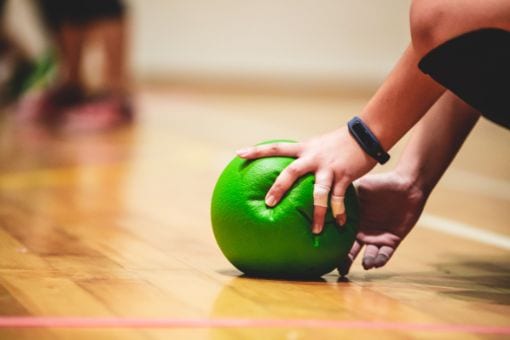 Formerly known as ‘Mintonette’, volleyball began in American universities where the physical education director, William G Morgan developed the game. The first set of rules was published in 1895 when it became an international sport. Nowadays, it’s an Olympic sport and has been for over 50 years.
Formerly known as ‘Mintonette’, volleyball began in American universities where the physical education director, William G Morgan developed the game. The first set of rules was published in 1895 when it became an international sport. Nowadays, it’s an Olympic sport and has been for over 50 years.
The rules of volleyball are intricate with many nuances but as a rule of thumb, there are six players on each team with one player designated as a ‘libero’ (or defensive specialist) that can only play within their own court area. Teams score points by hitting or touching the ball back over a net into their opponents’ side after they have served it across their net and before it touches the ground twice. If the ball touches the ground twice, the opposing team wins a point.
The libero player can only play within their own side of the court and cannot attack or touch a serve. In exchange, they are allowed to make plays from any position on the floor, as well as have more freedom in blocking around the net.
There are techniques, moves and strategies necessary for playing volleyball. For example, you should dig (or jump) hard when receiving serves, so you’re not toppled over by an opponent. When jumping high, it’s best to do two things: first, take off with your legs. Second, simultaneously rotate your arms up after; also be sure not to lean too far forward because this will cause you to land awkwardly and fall out of bounds. Digging is done less aggressively than spiking but at a much faster speed!
It sounds complex because in some ways the rules are but that’s all part of the game. It’s all part of the joy that comes with playing the game.
Ultimate frisbee (also known as ‘Ultimate’) is a sport that originates from the late 60s. The game has gone through some changes over the years, but it retains its defining characteristics of being fast-paced and self-officiating. Players call their own fouls and make quick decisions with a disc as they advance downfield on defence or offence. Ultimate frisbee is often played in teams of seven players, but two people can also play.
There are many variations of rules, which are simple in theory but challenging in practise. Most games involve two teams playing against each other over three periods of 20 minutes each. Switching sides for half-time between periods one and two, and halfway through period three. The team scoring the most points at the end wins!
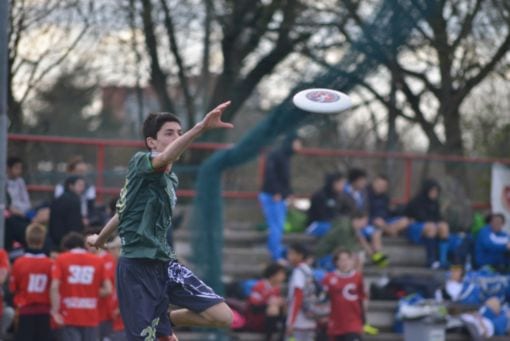 The object of an ultimate game is to score more goals (called ‘points’) than your opponent. And do so by catching discs in goals defended by opposing players; throws must be made from behind the goal line.
The object of an ultimate game is to score more goals (called ‘points’) than your opponent. And do so by catching discs in goals defended by opposing players; throws must be made from behind the goal line.
Similar to touch football, players can pass the disc back and forth, but they cannot run while holding the disc. Although they may pivot around one foot (called ‘stalling’). When not stalling, offensive players must throw from behind their own goal line.
The most notable aspect of Ultimate is the focus on the spirit of sportsmanship and fair play. While the game is incredibly competitive, and these competitive traits are encouraged, it is never at the expense of the mutual respect and bond between players on the same teams or the opposing teams. Adhering to these qualities, according to those who play ultimate, encourages a basic ‘joy of play’. A sign of true sportsmanship.
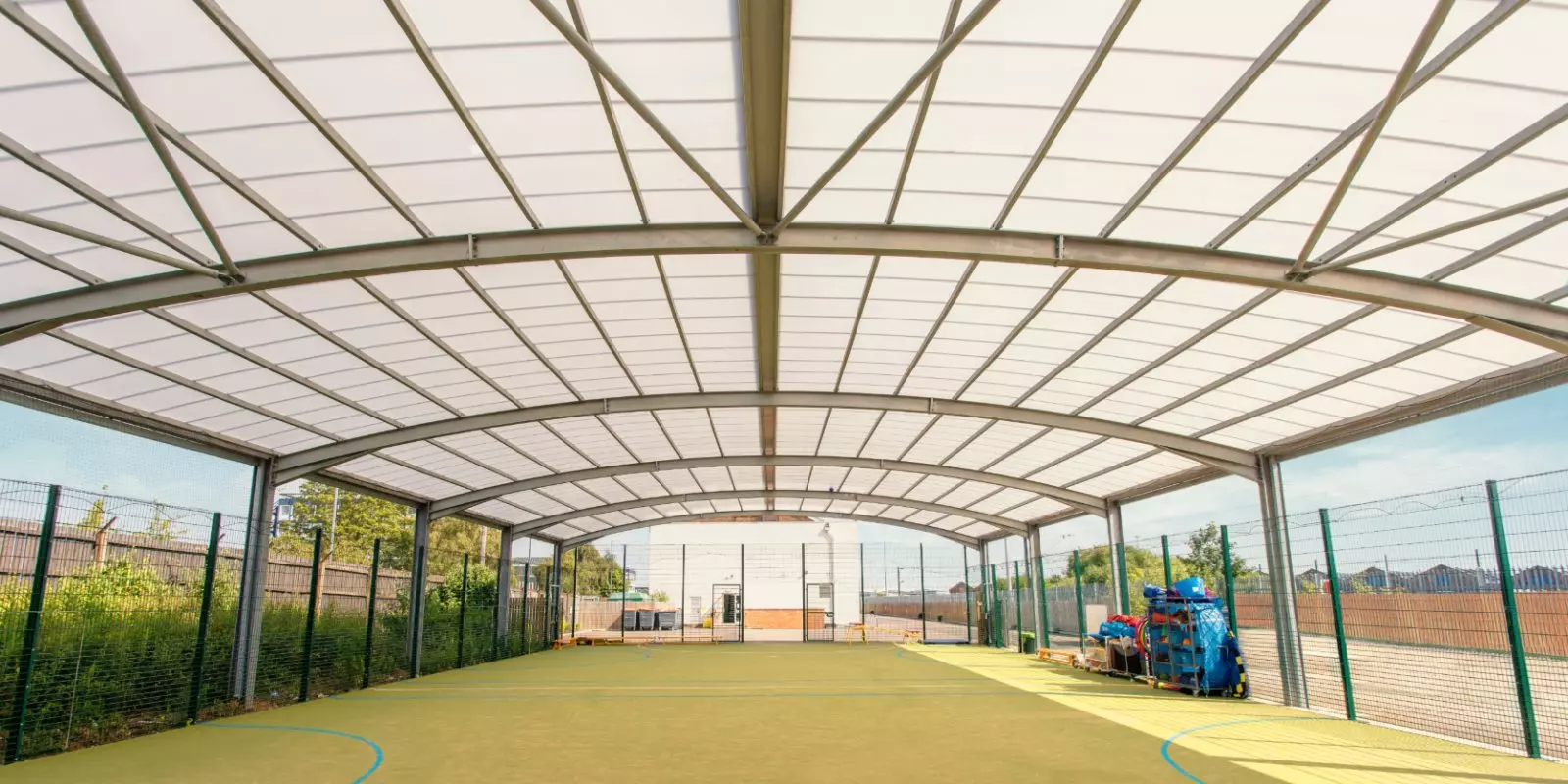
Send us your email and an idea of your requirements and we'll get back to you with a quick price.